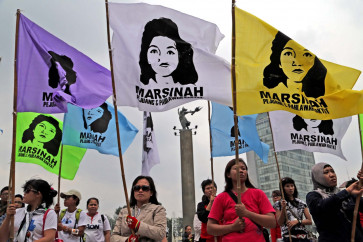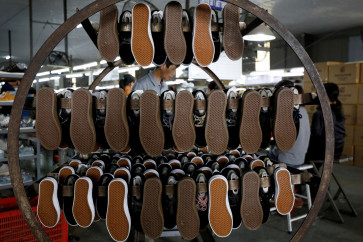Popular Reads
Top Results
Can't find what you're looking for?
View all search resultsPopular Reads
Top Results
Can't find what you're looking for?
View all search resultsPDI-P’s transformation: From complementary entity to political stardom
It’s official: The national congress of the Indonesian Democratic Party (PDI) on Dec
Change text size
Gift Premium Articles
to Anyone
I
t’s official: The national congress of the Indonesian Democratic Party (PDI) on Dec. 22, 1993, elected Megawati Soekarnoputri, the eldest daughter of founding president Sukarno, as chairwoman for the 1993 to 1998 leadership period. PDI was an amalgamation of five political parties, which agreed to coalesce on Jan. 10, 1973, following a People’s Consultative Assembly decree on the simplification of political parties. (JP/Arief Hidayat)
The rise of the Indonesian Democratic Party of Struggle (PDI-P) — the winner of the last two national legislative and presidential elections in 2014 and 2019 — has been almost beyond imagination. After being a pariah political party throughout the three-decade rule of the New Order administration, when it was called the Indonesian Democratic Party (PDI), it has taken the lead in the country’s political affairs since the start of the Reform Era in 1998.
The success of the PDI-P, the ideological “offspring” of the former PDI, in achieving its current status as the leading member of the coalition government — if not the ruling political party — perhaps follows the law of nature that likens life to a rotating wheel: One day you might be at the lowest point, but you will certainly find yourself at the top someday.
The chronology of events since the PDI’s birth on Jan. 10, 1973, as a merger of five political parties — the Indonesian National Party (PNI), the Independence Vanguard Party (IPKI), the Proletarian Consensus (Murba) Party, the Indonesian Christian Party (Parkindo) and the Indonesian Catholic Party — until 2019’s general elections has shown how the wheel has turned for the PDI-P.
The PDI was never able to flex its muscle, let alone excel in the guided and repressive political environment of the New Order government of president Soeharto. Throughout its participation in five general elections — in 1977, 1982, 1987, 1992 and 1997 — the party consistently finished third out of the three competing parties, behind perennial winner the Golkar Party or Golongan Karya, a secular-nationalist political organization founded by Soeharto in the wake of founding president Sukarno’s downfall in 1967, and the United Development Party (PPP).
However, despite finishing third in all five general elections, the PDI managed to steadily pick up more and more seats in the and House of Representatives, particularly in the 1987 and 1992 elections. The party’s improving election performance, analysts have noted, was in particular owed to the active involvement of Megawati Soekarnoputri, the eldest daughter of Sukarno, who served as a PDI executive since 1986.
As a legislative candidate for the PDI, along with her younger brother Guruh Soekarnoputra, Megawati actively engaged in the party’s election campaigns, and is believed to have contributed significantly to the PDI’s increasing success in the 1987 and 1992 elections. She even won the party’s chairpersonship in an extraordinary congress in Surabaya, East Java, in December 1993.
Her fame — and eventually her party leadership — dismayed the ruling government. A government-sanctioned party congress was held in Medan, North Sumatra, in June 1996 where Soerjadi was elected as PDI chairman. Megawati did not acknowledge the Medan congress and its results and refused to handover the party’s headquarters on Jl. Diponegoro in Central Jakarta to the government-sanctioned Soerjadi-led party structure.
Her opposition eventually led to the forced takeover of the PDI headquarters, reportedly by Soerjadi’s supporters, on July 27, 1996. The tragedy led to the deaths of five people and left 149 others injured, according to a report by the National Commission on Human Rights (Komnas HAM).
The leadership split in the PDI led to a drastic decline in its performance in the 1997 general elections, in which it secured just 3 percent of the vote and 11 seats in the House, down from 15 percent and 56 House seats in the previous 1992 elections. The results of the 1997 elections were the party’s worst in its history.
With the Soerjadi-led PDI the eligible contestant in the 1997 elections, Megawati publicly declared she would be a golput (nonvoter or abstainer) in the run-up to voting day, while her supporters opted to shift their allegiance to the PPP, a maneuver popularly known at the time as the “Mega-Bintang” phenomenon — Mega is Megawati’s nickname, while a bintang (star) was the PPP’s logo.
The decisive and critical events a year later — months of political turmoil after the 1997 elections followed by the 1997/1998 Asian financial crisis — led to Soeharto’s downfall in May 1998, which changed the country’s political course. Soeharto was replaced by his then-vice president BJ Habibie.
The opposition of the People’s Consultative Assembly, then the country’s supreme lawmaking institution, to Habibie’s accountability speech, led to the organization of a legislative election on July 7, 1999. A total of 48 political parties took part in the election, which was won by the PDI-P.
The indirect presidential election organized by the Assembly on Oct. 20, 1999, was not won by Megawati, but her close friend Abdurrahman “Gus Dur” Wahid. She eventually became president in July 2001 after the Assembly revoked the mandate it had given to Gus Dur.
Megawati and her PDI-P, however, failed to maintain its supremacy in the 2004 general elections. The April 5, 2004, legislative election was won by Golkar, while Megawati, who had partnered with Hasyim Muzadi, lost her bid to remain as the country’s leader in the two-round direct presidential election on July 5 and Sept. 20 of 2004. Instead, the presidency was won by Susilo Bambang Yudhoyono of the Democratic Party and his vice president pick Jusuf Kalla.
Megawati and the PDI-P also lost the legislative and presidential elections in 2009. While the PDI-P finished third in the legislative election after the Democrats and Golkar, Megawati, who this time partnered with Prabowo Subianto, was again defeated by Yudhoyono, who partnered with Boediono.
However, the losses in two consecutive general elections in 2004 and 2009, turned out to be a blessing in disguise for the PDI-P. Despite protests, including within the party, as chairwoman, Megawati decided that the PDI-P would not seek a seat in either of Yudhoyono’s first or second term Cabinets, and would instead focus on consolidating the party during its 10 years out of power.
Her decision proved to be the right one, as the PDI-P has gone on to win the last two legislative and presidential elections. Time will tell whether the PDI-P will make it a three-peat in the 2024 general elections.










